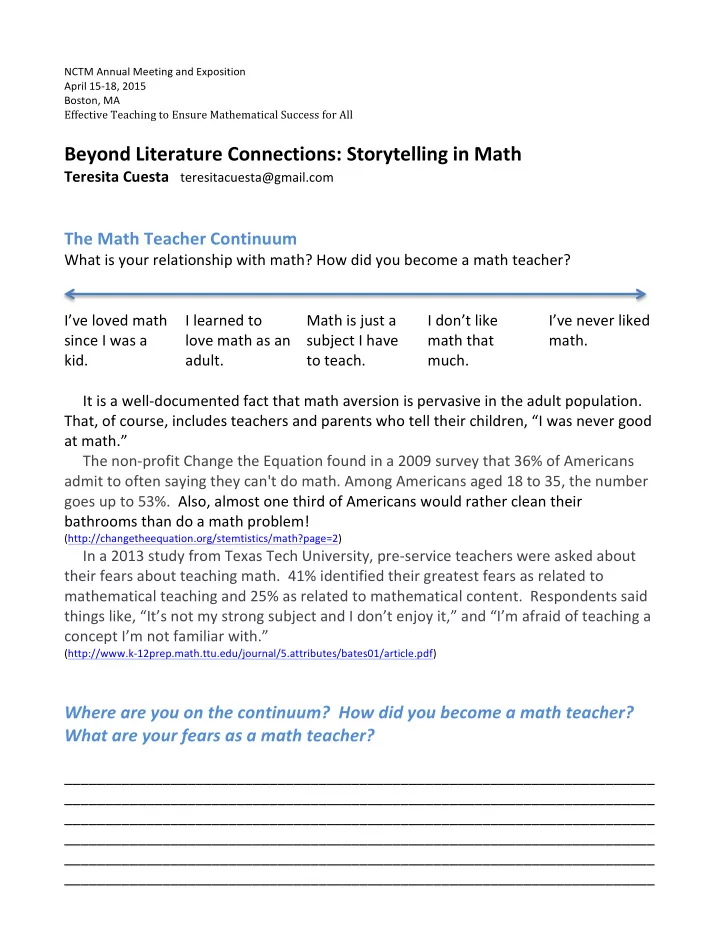

NCTM ¡Annual ¡Meeting ¡and ¡Exposition ¡ April ¡15-‑18, ¡2015 ¡ Boston, ¡MA ¡ Effective ¡Teaching ¡to ¡Ensure ¡Mathematical ¡Success ¡for ¡All ¡ ¡ Beyond ¡Literature ¡Connections: ¡Storytelling ¡in ¡Math ¡ Teresita ¡Cuesta ¡ ¡ ¡ teresitacuesta@gmail.com ¡ ¡ ¡ The ¡Math ¡Teacher ¡Continuum ¡ What ¡is ¡your ¡relationship ¡with ¡math? ¡How ¡did ¡you ¡become ¡a ¡math ¡teacher? ¡ ¡ ¡ I’ve ¡loved ¡math ¡ I ¡learned ¡to ¡ Math ¡is ¡just ¡a ¡ I ¡don’t ¡like ¡ I’ve ¡never ¡liked ¡ since ¡I ¡was ¡a ¡ love ¡math ¡as ¡an ¡ subject ¡I ¡have ¡ math ¡that ¡ math. ¡ kid. ¡ adult. ¡ to ¡teach. ¡ much. ¡ ¡ ¡ ¡ ¡ ¡ ¡It ¡is ¡a ¡well-‑documented ¡fact ¡that ¡math ¡aversion ¡is ¡pervasive ¡in ¡the ¡adult ¡population. ¡ ¡ That, ¡of ¡course, ¡includes ¡teachers ¡and ¡parents ¡who ¡tell ¡their ¡children, ¡“I ¡was ¡never ¡good ¡ at ¡math.” ¡ ¡ ¡ ¡ ¡ ¡The ¡non-‑profit ¡Change ¡the ¡Equation ¡found ¡in ¡a ¡2009 ¡survey ¡that ¡36% ¡of ¡Americans ¡ admit ¡to ¡often ¡saying ¡they ¡can't ¡do ¡math. ¡Among ¡Americans ¡aged ¡18 ¡to ¡35, ¡the ¡number ¡ goes ¡up ¡to ¡53%. ¡ ¡Also, ¡almost ¡one ¡third ¡of ¡Americans ¡would ¡rather ¡clean ¡their ¡ bathrooms ¡than ¡do ¡a ¡math ¡problem! ¡ ¡ (http://changetheequation.org/stemtistics/math?page=2) ¡ ¡ ¡ ¡ ¡ ¡In ¡a ¡2013 ¡study ¡from ¡Texas ¡Tech ¡University, ¡pre-‑service ¡teachers ¡were ¡asked ¡about ¡ their ¡fears ¡about ¡teaching ¡math. ¡ ¡41% ¡identified ¡their ¡greatest ¡fears ¡as ¡related ¡to ¡ mathematical ¡teaching ¡and ¡25% ¡as ¡related ¡to ¡mathematical ¡content. ¡ ¡Respondents ¡said ¡ things ¡like, ¡“It’s ¡not ¡my ¡strong ¡subject ¡and ¡I ¡don’t ¡enjoy ¡it,” ¡and ¡“I’m ¡afraid ¡of ¡teaching ¡a ¡ concept ¡I’m ¡not ¡familiar ¡with.” ¡ (http://www.k-‑12prep.math.ttu.edu/journal/5.attributes/bates01/article.pdf) ¡ ¡ ¡ Where ¡are ¡you ¡on ¡the ¡continuum? ¡ ¡How ¡did ¡you ¡become ¡a ¡math ¡teacher? ¡ What ¡are ¡your ¡fears ¡as ¡a ¡math ¡teacher? ¡ ¡ ________________________________________________________________________ ________________________________________________________________________ ________________________________________________________________________ ________________________________________________________________________ ________________________________________________________________________ ________________________________________________________________________ ¡
The ¡Impact ¡of ¡Emotions ¡ ¡ ¡ ¡ ¡ ¡ ¡In ¡the ¡past ¡decade, ¡neuroscientific ¡research ¡has ¡exploded, ¡revealing ¡how ¡the ¡ interrelation ¡of ¡brain ¡functions ¡affect ¡learning. ¡ ¡Best ¡practices ¡based ¡on ¡this ¡research ¡are ¡ geared ¡toward ¡creating ¡optimal ¡conditions ¡for ¡the ¡brain ¡to ¡access ¡higher ¡order ¡thinking, ¡ learn, ¡and ¡remember. ¡ ¡Paramount ¡among ¡these ¡best ¡practices ¡are ¡reducing ¡anxiety, ¡ fostering ¡enthusiasm, ¡and ¡creating ¡a ¡sense ¡of ¡community ¡support. ¡ http://www.edutopia.org/blog/neuroscience-‑behind-‑stress-‑and-‑learning-‑judy-‑willis ¡ www.RADTeach.com ¡ ¡ ¡ What ¡do ¡you ¡know ¡about ¡the ¡brain ¡and ¡learning? ¡ ¡What ¡techniques ¡do ¡you ¡ use ¡to ¡promote ¡optimal ¡brain ¡conditions ¡in ¡your ¡students? ¡ ¡ ________________________________________________________________________ ________________________________________________________________________ ________________________________________________________________________ ________________________________________________________________________ ________________________________________________________________________ ________________________________________________________________________ ¡ ¡ ¡ ¡ Storytelling ¡in ¡Math ¡ ¡ ¡ ¡ ¡ ¡Children ¡grow ¡up ¡hearing ¡and ¡telling ¡stories. ¡ ¡It ¡is ¡a ¡natural ¡part ¡of ¡their ¡development. ¡ ¡ Once ¡they ¡enter ¡school, ¡story ¡time ¡is ¡a ¡constant ¡in ¡most ¡students’ ¡lives. ¡ ¡This ¡familiarity ¡ can ¡be ¡used ¡as ¡a ¡bridge ¡to ¡math. ¡ ¡By ¡weaving ¡storytelling ¡–which ¡is ¡different ¡from ¡ literature ¡connections-‑ ¡into ¡their ¡lessons, ¡teachers ¡can ¡build ¡confidence, ¡spark ¡curiosity, ¡ develop ¡algebraic ¡thinking, ¡strengthen ¡communication ¡skills, ¡and ¡foster ¡metacognition. ¡ ¡ Additionally, ¡storytelling ¡is ¡an ¡effective ¡way ¡to ¡differentiate ¡instruction. ¡ ¡ ¡ How ¡have ¡you ¡used ¡storytelling ¡in ¡your ¡teaching? ¡ ¡How ¡have ¡you ¡used ¡story ¡ telling ¡in ¡teaching ¡math? ¡ ¡ ________________________________________________________________________ ________________________________________________________________________ ________________________________________________________________________ ________________________________________________________________________ ________________________________________________________________________ ________________________________________________________________________ ¡
The ¡Math ¡Student ¡Continuum ¡ ¡ ¡ ¡ ¡ ¡Children ¡start ¡establishing ¡their ¡identity ¡at ¡a ¡very ¡young ¡age. ¡ ¡They ¡also ¡establish ¡their ¡ identity ¡as ¡students ¡in ¡the ¡early ¡grades. ¡ ¡Part ¡of ¡this ¡identity ¡is ¡the ¡student’s ¡relationship ¡ with ¡math. ¡This ¡is ¡particularly ¡important ¡for ¡girls. ¡ ¡A ¡2011 ¡study ¡at ¡University ¡of ¡ Washington ¡found ¡that, ¡as ¡early ¡as ¡second ¡grade, ¡boys ¡and ¡girls ¡had ¡different ¡attitudes ¡ toward ¡math ¡and ¡associated ¡boys ¡with ¡math ¡and ¡girls ¡with ¡reading. ¡ http://faculty.washington.edu/agg/pdf/Cvencek&al.ChDevel.2011.pdf ¡ ¡ ¡ ¡ ¡ ¡Independent ¡of ¡their ¡gender ¡and ¡whether ¡they ¡fall ¡in ¡this ¡stereotype ¡or ¡not, ¡students ¡ tend ¡to ¡gravitate ¡toward ¡one ¡subject ¡more ¡than ¡the ¡other. ¡ ¡ ¡ ¡ *Loves ¡story ¡lines, ¡gets ¡ *Likes ¡nonfiction. ¡ ¡ *Loves ¡patterns, ¡logical ¡ attached ¡to ¡characters ¡ *Enjoys ¡the ¡process, ¡wants ¡ premises, ¡and ¡quantities. ¡ *Process-‑oriented ¡ the ¡results ¡ *Results-‑oriented ¡ *Numbers ¡are ¡just ¡words ¡ *Has ¡number ¡sense. ¡ *Has ¡difficulty ¡explaining ¡in ¡ words. ¡ ¡ ¡ ¡ ¡ ¡ ¡Using ¡storytelling ¡in ¡math ¡fosters ¡growth ¡at ¡both ¡ends ¡of ¡the ¡spectrum. ¡ ¡For ¡those ¡ who ¡are ¡more ¡verbal ¡oriented, ¡storytelling ¡plays ¡to ¡their ¡strengths ¡and ¡preferences, ¡ replacing ¡fear ¡of ¡math ¡with ¡a ¡positive ¡bond ¡while ¡strengthening ¡their ¡understanding ¡of ¡ math ¡concepts. ¡ ¡For ¡those ¡who ¡are ¡more ¡analytical ¡oriented, ¡storytelling ¡facilitates ¡a ¡ focus ¡on ¡process ¡that ¡will ¡enhance ¡their ¡understanding ¡and ¡their ¡ability ¡to ¡communicate ¡ their ¡thinking. ¡ ¡ ¡ Think ¡of ¡a ¡few ¡of ¡your ¡students. ¡ ¡Where ¡would ¡you ¡place ¡them ¡on ¡the ¡ continuum? ¡ ¡How ¡have ¡you ¡addressed ¡their ¡needs? ¡ ¡ ________________________________________________________________________ ________________________________________________________________________ ________________________________________________________________________ ________________________________________________________________________ ________________________________________________________________________ ________________________________________________________________________ ¡ ¡ ¡ ¡ ¡ ¡ ¡
Recommend
More recommend